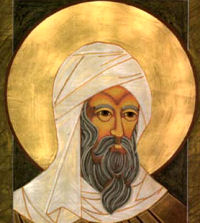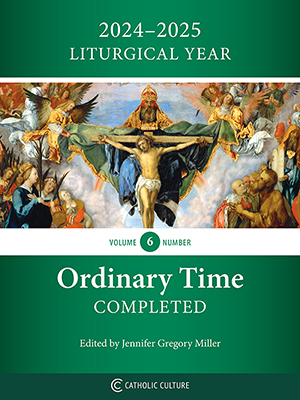Make your gift today!
Help keep Catholics around the world educated and informed.
Already donated? Log in to stop seeing these donation pop-ups.
Advent: December 4th
Wednesday of the First Week of Advent; Optional Memorial of St. John Damascene, priest and doctor
Other Commemorations: St. Barbara, Virgin and Martyr (RM); St. Osmund, Bishop (RM)
» Enjoy our Liturgical Seasons series of e-books!
St. John Damascene was a learned theologian who carefully gathered together and transmitted to us the teaching of the Greek Fathers, and is thus one of the most trustworthy witnesses to oriental tradition. He also wrote many liturgical hymns still in use today. St. John Damascene died in 749. Leo XIII proclaimed him a Doctor of the universal Church. His feast in the Extraordinary Form of the Roman Rite is celebrated March 27.
According to the 1962 Missal of St. John XXIII the Extraordinary Form of the Roman Rite, today is the feast of St. Peter Chrysologus, bishop, confessor and doctor whose feast in the Ordinary Form of the Roman Rite is celebrated on July 30. It is also the feast of St. Barbara, a virgin and martyr who died at Nicomedia about 235.
St. John Damascene
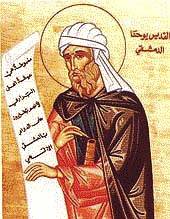 John of Damascus or Damascene, the last of the Greek Fathers, was one of the principal defenders of the veneration of images against the Iconoclasts, who condemned this practice.
John of Damascus or Damascene, the last of the Greek Fathers, was one of the principal defenders of the veneration of images against the Iconoclasts, who condemned this practice.
When John was born, Damascus was under the jurisdiction of caliphs, but Christians were allowed to hold high offices. John's father was chief revenue officer of the caliph and a sterling Christian. He entrusted his son's education to a monk, Cosmas, who had been brought from Sicily as a slave, and who schooled the young man in theology, the sciences, and poetry.
John succeeded his father in office, and while living at the court gave an example of a model Christian. But he had set his sights higher, and after resigning his office he became a monk at St. Sabbas monastery near Jerusalem. Here he spent his time writing books and composing hymns. When Leo the Isaurian issued decrees against the veneration of images, John took up the challenge and wrote treatises defending this ancient practice.
At this time the Patriarch of Jerusalem, desirous of having John among his clergy, ordained him priest and brought him to Jerusalem. After some time, however, John returned to the monastery and devoted the rest of his life to writing. His most important work is his Fountain of Wisdom, in which he compiled and collated the teachings of all the great theologians before him; this is the first attempt at a Summa Theologica, a summary of philosophy and theology, that has come down to us. John's writings are a rich treasure of ancient traditions, and are held in high esteem. Pope Leo XIII declared him a Doctor of the Church in 1890.
St. John was such a great orator that he was known as Chrysorrhoas ("golden-stream"). He was the last of the Greek Fathers of the Church, and the first of the Christian Aristotleans. He also adapted choral music for use in the liturgy. His eloquent defense of Christian images has given him the title of "Doctor of Christian Art."
—A Saint A Day © 1957
Patronage: pharmacists; icon painters; sick children; theology students
Symbols and Representation: with his severed hand; with a Marian icon
Highlights and Things to Do:
- St. John Damascene has contributed much to the Church through his writings. Read all or part of his most famous work, Exposition of the Orthodox Faith.
- Listen to the Catholic Culture podcasts:
- Audiobook by James Majewski, St. John Damascene—Sermon on the Assumption
- Way of the Fathers with Mike Aquilina, 56—John of Damascus: Last Witness to a Lost World
- Check out some ideas for Celebrating the Feast of St. John Damascene.
- Read more about St. John Damascene:
- He was famous for his opposition to the heresy of the Iconoclasts: you could find out more about this heresy.
- Learn more about Catholic Sacramentals which include statues and images.
- St. John Damascene was made a Doctor of the Church for his efforts to defend the faith, learn to defend the use of religious pictures and objects to your Protestant friends.
St. Barbara
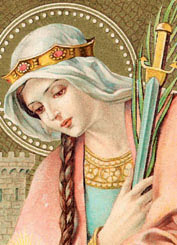 Barbara (from Nicomedia) was the daughter of a pagan noble who worshipped false gods. Because of her striking beauty, her father enclosed her in a tower to hide her from the snares of men. Barbara vowed virginity, and during an absence of her father had a third window added to her quarters in honor of the Blessed Trinity; at the same time, she also adorned her bath with the sign of the holy Cross. Upon his return her father was so angered over these changes that a miracle was needed to save her life. She was presented before the magistrate, subjected to much torturing, and finally her own father wielded the sword that severed her head. Immediately God's vengeance struck him dead. The holy virgin is highly honored both in the East and the West as patroness of artillery men and of miners. She is especially invoked for preservation from sudden death. She is one of the "Fourteen Holy Helpers."
Barbara (from Nicomedia) was the daughter of a pagan noble who worshipped false gods. Because of her striking beauty, her father enclosed her in a tower to hide her from the snares of men. Barbara vowed virginity, and during an absence of her father had a third window added to her quarters in honor of the Blessed Trinity; at the same time, she also adorned her bath with the sign of the holy Cross. Upon his return her father was so angered over these changes that a miracle was needed to save her life. She was presented before the magistrate, subjected to much torturing, and finally her own father wielded the sword that severed her head. Immediately God's vengeance struck him dead. The holy virgin is highly honored both in the East and the West as patroness of artillery men and of miners. She is especially invoked for preservation from sudden death. She is one of the "Fourteen Holy Helpers."
In the past, the following prayer to St. Barbara was often recited:
Saint Barbara, thou noble bride,
To thee my body I confide
As well in life as at life's end.
Come, aid me when I breathe my last,
That I may, ere here all is past,
Receive the Blessed Sacrament!
In certain parts of Europe, the so-called "Barbara branch" is brought into homes today. It consists of a small cherry twig that is set in water and should blossom on Christmas eve. The custom is deeply Biblical and liturgical. "The bud from the root of Jesse and the flower from its root" is Jesus Christ, whom we expectantly await during Advent and who will blossom forth as a flower at Christmas.
Patronage: against death by artillery; against explosions; against fire; against impenitence; against lightning; against mine collapse; against storms; ammunition magazines; ammunition workers; architects; armourers; artillery; artillerymen; boatmen; bomb technicians; brass workers; brewers; builders; carpenters; construction workers; dying people; explosives workers; fire; fire prevention; firefighters; fireworks; fireworks manufacturers; fortifications; founders; geologists; gravediggers; gunners; hatmakers; hatters; lightning; mariners; martyrs; masons; mathematicians; military engineers; milliners; miners; ordnance workers; prisoners; safety from storms; sailors; saltpeter workers; smelters; stone masons; stonecutters; storms; sudden death; Syria; tilers; warehouses; watermen
Symbols: cannon; chalice; host and paten; tower with three windows; tower and palm; monstrance; peacock feather; torches; fortress; spears; crown; book; sword; palm of martyrdom.
Often Portrayed As: princess in a tower with either the palm of martyrdom or chalice of happy death; woman holding a tower or feather; woman trampling a Saracen
Highlights and Things to Do:
- Check out Celebrating for the Feast of St. Barbara in the Activities section. See also Painting Angels, Saints and Their Symbols for a description of St. Barbara's symbols.
- Have a St. Barbara's Party, Syrian Style.
- For further reading about St. Barbara:
- Read about the German custom of St. Barbara's Twig, where every member of the family puts a small cherry or peach branch into water so that it will blossom on Christmas. If you have a young lady in your home desiring marriage, the custom of St. Barbara's Cherry Twigs will have St. Barbara pick the right husband for young unmarried girls. An alternative idea to this custom would be forcing Amaryllis or other bulbs to bloom for Christmas. Start the bulbs today!
- St. Barbara is the patron of artillerymen. Offer your rosary or say a prayer for all our enlisted men and women who are in harm's way. This page provides the Legend of St. Barbara and the explanation why she is the patron of artillerymen. Read the Ballad of St. Barbara by G. K. Chesterton.
- See the statue of St. Barbara on St. Peter's Basilica Colonnade.
- Check out Christian Iconography and Olga's Gallery for artistic images of St. Barbara.
- Read about Barbórka, Miners Day, which is celebrated in Poland and other European countries.
- St. Barbara is included in the list of Fourteen Holy Helpers.. See August 8 for more details.
- See St. Barbara's statue on St. Peter Basilica's Colonnade
St. Osmund
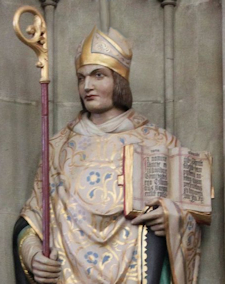 St. Osmund was the Bishop of Salisbury who helped compile the Domesday Book. A member of the Norman nobility, he was the son of Count Henry of Seez and Isabella, half-sister of King William the Conqueror of England.
St. Osmund was the Bishop of Salisbury who helped compile the Domesday Book. A member of the Norman nobility, he was the son of Count Henry of Seez and Isabella, half-sister of King William the Conqueror of England.
He took part in the Norman Conquest and served Williamas his chancellor. In 1078, he was appointed bishop of Salisbury, completing the cathedral there and founding a cathedral chapter of canons regular and school for clerics.
St. Osmund also assisted the king in assembling the massive census which became the Domesday Book. In the dispute over investiture between King William II and St. Anselm of Canterbury, Osmund initially sided with the king, but later he admitted he had made a mistake, and he begged Anselm's forgiveness.
Osmund also collected manuscripts for the cathedral library, was a copier and binder of books, authored a life of St. Aldhelm, and was thought to be responsible for drawing up the books governing the liturgical matters for the diocese such as the Mass and Divine Office, the so-called Sarum Use.
He was canonized in 1457 by Pope Callistus III, and was the last English person to be declared a saint until the canonization of Sts. Thomas More and John Fisher in 1935.
—Excerpted from Catholic Online
Patronage: against insanity; against mental illness; against paralysis; against ruptures; against toothache; mentally ill people; paralysed people; Salisbury, England
Highlights and Things to Do:
- Learn more about St. Osmund:
- For more information about the Doomsday Book see this article.


